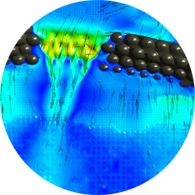Spatial rainfall estimates using improved observations from commercial microwave links and statistical data fusion (SpraiLINK)
Opportunistic sensing can greatly improve spatial and temporal resolution of standard precipitation monitoring networks by complementing them with measurements from devices primarily not intended for precipitation monitoring such as commercial microwave links (CML) from terrestrial networks. This is especially relevant for mitigation of dangerous flash floods in mountainous regions or in urbanized catchments, which are related to ongoing increase in frequency and magnitude of extreme rainfall events. The project investigates improved methods and models for quantitative precipitation estimates including its uncertainty using multiple CMLs with different propagation characteristics and data assimilation methods based on stochastic Random Mixing approach leading to improved spatial rainfall estimates. The methods are tested in two sites with different size, land use and terrain morphology – urbanized area of the city of Prague and natural catchment of Ore mountains.
The goal of the project is to develop methods for improving precipitation estimates and their uncertainties retrieved from a network of terrestrial microwave links and methods for rainfall spatial reconstruction via statistical data fusion with existing radar and ground observations.
Blettner, N., Fencl, M., Bareš, V., Kunstmann, H., & Chwala, C. (2023). Transboundary rainfall estimation using commercial microwave links. Earth and Space Science, 10, e2023EA002869. https://doi.org/10.1029/2023EA002869
Špačková, A., Fencl, M., and Bareš, V. (2023). Evaluation of error components in rainfall retrieval from collocated commercial microwave links, Atmos. Meas. Tech., https://doi.org/10.5194/amt-2022-340
Pastorek, J., Fencl, M. and Bareš, V. (2023). Uncertainties in discharge predictions based on microwave link rainfall estimates in a small urban catchment, Journal of Hydrology, Volume 617, Part C, 2023, 129051. https://doi.org/10.1016/j.jhydrol.2022.129051
Pastorek, J., Fencl, M., Rieckermann, J., and Bareš, V. (2022). Precipitation Estimates From Commercial Microwave Links: Practical Approaches to Wet-Antenna Correction, IEEE Trans. Geosci. Remote. Sens., https://doi.org/10.1109/TGRS.2021.3110004
Špačková, A., Bareš, V., Fencl, M., Schleiss, M., Jaffrain, J., Berne, A., and Rieckermann, J. (2021). A year of attenuation data from a commercial dual-polarized duplex microwave link with concurrent disdrometer, rain gauge, and weather observations, Earth Syst. Sci. Data, 13, 4219–4240, https://doi.org/10.5194/essd-13-4219-2021
Fencl, M., Dohnal, M., and Bareš, V. (2021). Retrieving Water Vapor From an E-Band Microwave Link With an Empirical Model Not Requiring In Situ Calibration. Earth and Space Science 8, no. 11, e2021EA001911, https://doi.org/10.1029/2021EA001911
Fencl, M., Dohnal, M., Valtr, P., Grabner, M and Bareš, V. (2020). Atmospheric observations with E-band microwave links - challenges and opportunities. Atmospheric Measurement Techniques. 2020, 13(12), 6559-6578, https://doi.org/10.5194/amt-13-6559-2020

